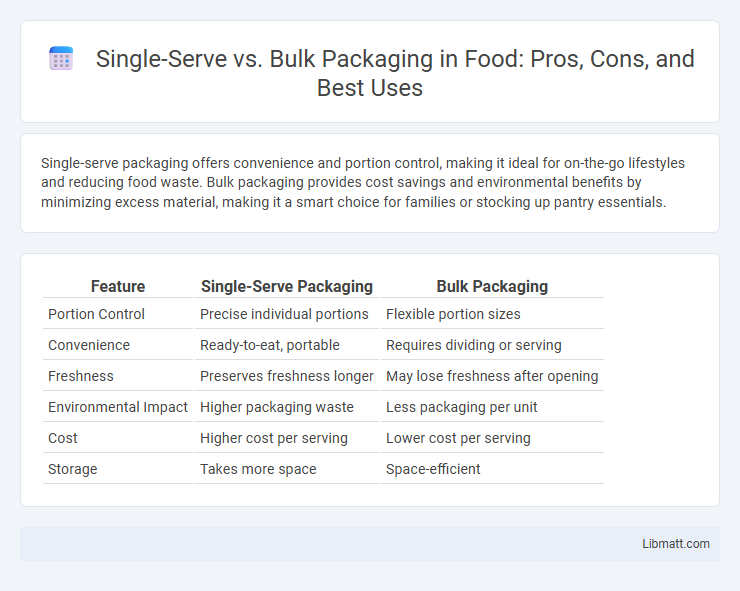Single-serve packaging offers convenience and portion control, making it ideal for on-the-go lifestyles and reducing food waste. Bulk packaging provides cost savings and environmental benefits by minimizing excess material, making it a smart choice for families or stocking up pantry essentials.
Table of Comparison
| Feature | Single-Serve Packaging | Bulk Packaging |
|---|---|---|
| Portion Control | Precise individual portions | Flexible portion sizes |
| Convenience | Ready-to-eat, portable | Requires dividing or serving |
| Freshness | Preserves freshness longer | May lose freshness after opening |
| Environmental Impact | Higher packaging waste | Less packaging per unit |
| Cost | Higher cost per serving | Lower cost per serving |
| Storage | Takes more space | Space-efficient |
Understanding Single-Serve Packaging
Single-serve packaging offers convenience and portion control, making it ideal for on-the-go consumption and reducing food waste. It typically uses less material per unit but can generate more overall packaging waste compared to bulk packaging. Understanding single-serve packaging helps you choose solutions that balance convenience with sustainability goals.
Exploring Bulk Packaging Solutions
Bulk packaging solutions offer a cost-effective and environmentally friendly alternative to single-serve options by reducing packaging waste and lowering material expenses. Companies utilizing bulk packaging benefit from streamlined logistics, decreased storage needs, and the ability to cater to large-scale consumption demands. This approach supports sustainability initiatives while enhancing operational efficiency and product accessibility.
Key Differences Between Single-Serve and Bulk Packaging
Single-serve packaging offers convenience, portion control, and reduced waste, making it ideal for on-the-go consumers and individual servings. Bulk packaging provides cost savings, environmental benefits through less material use, and is suited for families or businesses requiring larger quantities. Your choice depends on balancing convenience, cost-efficiency, and sustainability needs.
Environmental Impact Comparison
Single-serve packaging generates significantly more waste per unit compared to bulk packaging, contributing to higher environmental pollution and resource consumption. Bulk packaging reduces the carbon footprint by minimizing packaging materials and enabling more efficient transportation and storage. Choosing bulk options supports sustainability efforts by lowering plastic waste and conserving energy throughout the supply chain.
Cost Efficiency: Single-Serve vs Bulk
Single-serve packaging often incurs higher costs per unit due to increased materials and individual packaging processes, whereas bulk packaging significantly reduces packaging expenses by distributing large quantities together. Your choice impacts cost efficiency depending on consumption patterns; single-serve suits convenience and portion control while bulk packaging maximizes savings for frequent or large-volume use. Businesses and consumers must balance upfront costs with long-term value when deciding between single-serve and bulk options.
Consumer Convenience and Preferences
Single-serve packaging offers unmatched consumer convenience by providing precise portions that reduce waste and simplify on-the-go use, ideal for busy lifestyles. Bulk packaging appeals to cost-conscious consumers seeking lower price per unit and environmentally friendly options through reduced packaging materials. Your choice between single-serve and bulk ultimately depends on preferences for convenience, cost, and sustainability.
Product Freshness and Shelf Life
Single-serve packaging offers superior product freshness by minimizing exposure to air and contaminants, which preserves flavor and nutrients for each portion. Bulk packaging, while more economical, often experiences faster degradation once opened due to repeated exposure to moisture and oxygen, shortening overall shelf life. Proper sealing technologies in bulk containers can extend shelf life but typically cannot match the freshness retention of individually sealed portions.
Storage and Transportation Considerations
Single-serve packaging offers convenience and reduced storage space, making it ideal for on-the-go consumption and minimizing spoilage during transportation. Bulk packaging requires larger storage areas and more careful handling to prevent damage, but it often reduces packaging waste and lowers per-unit shipping costs. Your choice between single-serve and bulk packaging impacts logistics efficiency, cost, and inventory management strategies.
Industry Trends in Food and Beverage Packaging
Single-serve packaging in the food and beverage industry is rapidly growing due to consumer demand for convenience, portion control, and on-the-go consumption. Bulk packaging remains dominant for cost efficiency, sustainability, and reducing plastic waste in large-scale distribution. Innovations such as biodegradable materials and smart packaging technologies are reshaping both single-serve and bulk options to meet evolving environmental regulations and consumer preferences.
Choosing the Right Packaging for Your Product
Selecting the appropriate packaging involves evaluating product type, target market, and usage convenience. Single-serve packaging offers portion control and freshness, ideal for on-the-go consumers and minimizing waste. Bulk packaging benefits cost efficiency and environmental impact, making it suitable for high-volume users and reducing packaging materials.
Single-Serve vs Bulk Packaging Infographic

 libmatt.com
libmatt.com